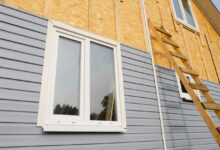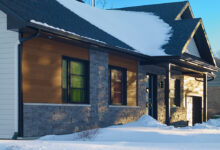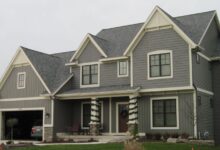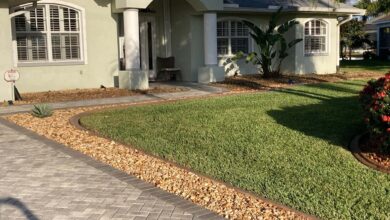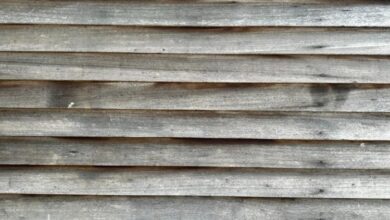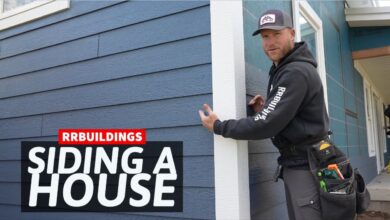Top Siding Options for Energy Efficiency
Top Siding Options for Energy Efficiency are crucial for homeowners seeking to reduce energy bills and enhance comfort. This exploration delves into various siding materials, analyzing their thermal properties, installation impacts, and long-term cost-effectiveness. We’ll examine the energy-saving potential of fiber cement, vinyl, wood, and metal siding, highlighting the advantages and disadvantages of each. Understanding these options empowers informed decisions for improved home energy performance and increased property value.
From the R-value of different materials to the influence of color on heat absorption, we’ll cover key factors affecting energy efficiency. We’ll also compare insulated siding systems to traditional options, analyzing their respective benefits and drawbacks. Ultimately, this guide aims to equip you with the knowledge to choose the best siding for your home’s specific needs and climate.
Introduction to Energy-Efficient Siding
Choosing energy-efficient siding can significantly reduce your home’s energy consumption and lower your utility bills. This translates to both cost savings and a smaller environmental footprint, making it a worthwhile investment for homeowners concerned about sustainability and financial responsibility. The right siding can dramatically improve your home’s insulation, keeping it warmer in winter and cooler in summer.
The energy efficiency of siding is determined by several key factors. These include the material’s inherent insulating properties (often measured by its R-value), its thickness, its density, the presence of any air gaps or insulation within the siding system, and even the color (darker colors absorb more heat). The way the siding is installed also plays a crucial role, with proper installation techniques minimizing gaps and air leaks that can compromise energy efficiency. For example, poorly installed vinyl siding can allow significant air infiltration, negating some of the material’s inherent benefits.
Siding R-Value and Energy Savings
The R-value of a siding material indicates its resistance to heat flow. A higher R-value signifies better insulation. This means that materials with higher R-values will help maintain a more consistent indoor temperature, reducing the strain on your heating and cooling systems. For instance, a home with siding boasting an R-value of 4 will experience less heat transfer than one with siding possessing an R-value of 2. This difference in R-value translates directly into lower energy consumption and reduced utility bills. The actual energy savings will vary based on factors like climate, home size, and existing insulation levels, but the correlation between higher R-value and energy savings is consistently observed. For example, a study conducted by the National Renewable Energy Laboratory (NREL) demonstrated a significant reduction in energy consumption in homes retrofitted with high R-value siding compared to those with lower R-value materials. This reduction was especially noticeable in climates with extreme temperature fluctuations.
Fiber Cement Siding
Fiber cement siding offers a compelling blend of durability, aesthetics, and energy efficiency, making it a popular choice for homeowners seeking long-term value and reduced energy costs. Its composition, a mixture of cement, cellulose fibers, and other additives, contributes significantly to its thermal performance and overall energy efficiency.
Fiber cement siding’s thermal performance stems from its inherent density and mass. This density helps to moderate temperature fluctuations within the home, reducing the strain on heating and cooling systems. Unlike some lighter materials, fiber cement doesn’t absorb heat as readily, minimizing heat transfer during the summer months and retaining warmth more effectively during winter.
Fiber Cement Siding’s Energy Efficiency Compared to Other Materials
The energy efficiency of fiber cement siding is often compared to other popular siding options such as vinyl, wood, and aluminum. While vinyl siding can be relatively inexpensive, it generally offers lower thermal resistance compared to fiber cement. Wood siding, while aesthetically pleasing, is susceptible to rot, insect damage, and requires more frequent maintenance. Aluminum siding, although durable, is a highly conductive material, leading to significant heat transfer and potentially higher energy bills. Fiber cement’s superior thermal performance and longevity contribute to long-term energy savings when compared to these alternatives. A well-insulated home with fiber cement siding can significantly reduce energy consumption.
The Influence of Fiber Cement Siding Thickness on Insulation
The thickness of fiber cement siding plays a crucial role in its insulating properties. Thicker fiber cement boards generally offer better thermal resistance. This is because a thicker material provides a greater barrier against heat transfer, thereby reducing the amount of energy needed to maintain a comfortable indoor temperature. For example, a 1/2-inch thick fiber cement board will offer better insulation than a 1/4-inch thick board. However, it’s important to note that the overall impact on energy efficiency also depends on other factors such as the insulation within the wall cavity and the overall design of the building envelope. The thicker the fiber cement board, the more effective it is at slowing down heat transfer, thus contributing to better energy efficiency.
Vinyl Siding
Vinyl siding presents a popular and cost-effective exterior cladding option for homeowners. Its relative affordability and ease of installation contribute to its widespread use. However, its energy efficiency performance varies depending on several key factors, making it crucial to understand these aspects before making a purchase decision.
Vinyl siding itself does not possess significant insulating properties. Its primary function is to act as a protective barrier against the elements, not as a thermal insulator like foam or fiberglass. Therefore, its contribution to overall home energy efficiency is indirect, primarily through its role in preventing air infiltration.
Vinyl Siding Insulating Properties
The insulating value of vinyl siding is minimal. It primarily protects the underlying wall assembly from the elements, preventing moisture penetration and reducing air leakage. Effective insulation lies within the wall cavity itself, typically using materials such as fiberglass batts, cellulose, or spray foam. Vinyl siding’s contribution is in preventing heat loss or gain through the wall’s exterior surface by minimizing air movement. A well-installed vinyl siding system can contribute to a slightly improved energy efficiency rating by reducing drafts and air infiltration.
Factors Affecting Vinyl Siding’s Energy Efficiency
Several factors significantly influence the energy efficiency performance of vinyl siding installations. These include the quality of installation, the presence and type of underlying insulation, and the overall design of the building envelope. Poor installation can lead to gaps and cracks, negating any potential energy savings. The use of high-performance insulation within the wall cavity is paramount. Additionally, the design of the building, such as window placement and overall airtightness, plays a vital role in the home’s overall energy performance.
Comparison of Vinyl Siding Types and Energy Efficiency
While the inherent insulating properties of vinyl siding itself remain consistent across different types, the overall energy efficiency of a vinyl siding system can vary due to factors beyond the siding material. The table below illustrates this concept. Note that the energy efficiency rating is an overall assessment, considering the impact of installation quality and underlying insulation, not solely the vinyl siding.
| Vinyl Siding Type | Energy Efficiency Impact (Qualitative) |
|---|---|
| Standard Vinyl Siding (single-wall) | Provides basic weather protection; energy efficiency depends heavily on proper installation and underlying insulation. |
| Premium Vinyl Siding (double-wall or insulated) | May offer slightly improved performance due to thicker construction, potentially reducing minor air infiltration. Still relies heavily on overall wall assembly performance. |
Wood Siding
Wood siding, a classic choice for home exteriors, offers a natural aesthetic appeal and can contribute to energy efficiency, though its performance depends heavily on the type of wood, its installation, and the climate. While not as inherently insulating as some other materials, strategic choices and proper installation can significantly improve a home’s energy performance.
Different wood species exhibit varying degrees of insulating properties. Cedar and redwood, for example, are popular choices due to their natural resistance to rot and insects, and their relatively high density contributes to some degree of insulation. However, their insulating value is still lower than that of materials like fiber cement or foam-backed vinyl siding.
Wood Siding Insulation Capabilities Compared to Other Materials
The thermal performance of wood siding is typically expressed using its R-value, which represents its resistance to heat flow. While the R-value of wood siding itself is relatively low (around R-0.9 per inch of thickness), its contribution to overall wall insulation is part of a system. The overall wall assembly, including insulation within the wall cavity, sheathing, and air sealing, significantly impacts energy efficiency. For instance, a wall with 6 inches of fiberglass insulation (R-19) will have far greater insulating capabilities than the wood siding alone, regardless of the wood type. In comparison, fiber cement siding generally has a slightly higher R-value than wood, while vinyl siding, especially foam-backed varieties, can offer substantially better insulation.
Impact of Proper Wood Siding Installation on Energy Efficiency
Proper installation is paramount to maximizing the energy efficiency of wood siding. Air gaps and leaks can drastically reduce the effectiveness of any siding material, including wood. Careful attention to detail during installation, including proper sealing around windows and doors, ensuring a tight fit between siding boards, and using appropriate flashing to prevent water penetration, all contribute to a more energy-efficient building envelope. A poorly installed wood siding system can lead to drafts, moisture intrusion, and increased energy consumption, negating any potential benefits of the wood itself.
Metal Siding
Metal siding, encompassing aluminum and steel options, presents a compelling choice for homeowners prioritizing both energy efficiency and longevity. Its inherent properties and design features contribute significantly to a home’s overall thermal performance and resistance to the elements. This section will explore the thermal characteristics of metal siding and compare its energy efficiency to other common siding materials.
Metal siding’s energy efficiency stems primarily from its reflective properties and thermal conductivity.
Thermal Properties of Metal Siding
Aluminum and steel, the most prevalent metals used in siding, possess relatively low thermal conductivity. This means they don’t readily transfer heat. Aluminum, in particular, excels at reflecting solar radiation, minimizing heat absorption during the summer months. Steel, while slightly less reflective than aluminum, offers superior strength and durability. The effectiveness of the reflective properties is significantly influenced by the siding’s color, as discussed below. The reflective nature of metal siding helps keep homes cooler in summer and reduces the load on air conditioning systems, leading to lower energy bills. In contrast, materials with high thermal conductivity, such as wood, tend to absorb heat more readily.
Energy Efficiency Comparison with Other Siding Materials
Compared to wood siding, metal siding generally offers superior energy efficiency due to its lower thermal conductivity and higher reflectivity. Vinyl siding, while offering decent insulation, typically falls short of metal siding in terms of reflectivity and long-term thermal performance. Fiber cement siding, though durable and energy-efficient, can be more expensive and heavier than metal siding. The precise energy savings will vary depending on factors such as climate, insulation levels, and the specific siding material used. For example, a home in a hot, sunny climate could see substantially greater energy savings with reflective metal siding compared to a home in a milder climate. A study conducted by the National Renewable Energy Laboratory (NREL) demonstrated significant energy savings in homes using highly reflective materials for roofing and siding in hot climates.
Impact of Metal Siding Color on Energy Efficiency
The color of metal siding significantly impacts its energy efficiency. Lighter colors, such as white or light gray, reflect a greater percentage of solar radiation, keeping the home cooler and reducing cooling energy consumption. Darker colors, conversely, absorb more solar radiation, potentially increasing cooling costs. The Solar Reflectance Index (SRI) is a valuable metric for assessing a material’s ability to reflect solar radiation and emit absorbed heat. Higher SRI values indicate better reflectivity and therefore greater energy efficiency. For example, a white metal siding might have an SRI of 80 or higher, while a dark brown siding might have an SRI of only 20. This difference in SRI translates directly to energy savings, especially in regions with intense sunlight.
Insulated Siding Systems
Insulated siding systems represent a significant advancement in energy-efficient home construction. These systems integrate insulation directly within the siding itself, creating a more effective thermal barrier compared to traditional siding installations where insulation is added separately. This integrated approach leads to substantial improvements in a home’s energy performance and overall comfort.
Insulated siding systems typically consist of an outer layer of siding material (such as vinyl, fiber cement, or even metal) and an inner layer of rigid foam insulation. The two layers are often mechanically fastened together to form a single, integrated unit. This differs from traditional methods where insulation is installed within the wall cavity separately from the exterior siding. The thickness of the insulation varies depending on the manufacturer and the climate zone, with thicker insulation providing greater energy savings. The precise construction methods can differ based on the specific siding material and manufacturer’s specifications.
Insulated Siding Performance Compared to Traditional Siding
The energy savings achieved with insulated siding systems are substantial when compared to traditional siding installations. A typical home with traditional siding and standard wall insulation might lose a significant amount of heat in winter and gain excessive heat in summer, leading to higher energy bills. With insulated siding, this heat transfer is significantly reduced. Studies have shown that insulated siding can reduce energy consumption by 15-30%, depending on factors like climate, existing insulation levels, and the R-value of the insulated siding system. For example, a home in a colder climate with poor insulation might see a greater percentage reduction in energy costs than a home in a milder climate with already good insulation. The R-value of the insulation is a key factor, with higher R-values indicating better insulation properties.
Benefits of Insulated Siding Systems
The advantages of choosing insulated siding extend beyond mere energy savings. Let’s consider some key benefits:
- Reduced Energy Costs: As previously mentioned, insulated siding leads to significantly lower heating and cooling bills due to reduced heat transfer through the walls.
- Improved Home Comfort: The consistent temperature maintained within the home improves comfort by minimizing temperature fluctuations caused by exterior temperature changes.
- Enhanced Sound Insulation: The rigid foam insulation layer in insulated siding systems provides a degree of sound dampening, reducing outside noise penetration.
- Simplified Installation: While the initial cost might be higher, the installation process is often faster and simpler than installing traditional siding and insulation separately, potentially saving on labor costs.
- Increased Durability: The integrated system can offer superior protection against weather damage compared to some traditional siding applications.
Impact of Siding Color on Energy Efficiency
The color of your siding plays a surprisingly significant role in your home’s energy efficiency. Different colors absorb and reflect solar radiation to varying degrees, directly impacting the amount of heat transferred into your home during summer and the amount of heat retained during winter. Understanding this relationship can help you make informed decisions when choosing siding for your home, potentially leading to substantial energy savings.
Siding color affects energy consumption primarily through its influence on solar heat gain. Lighter colors reflect more sunlight, reducing the amount of heat absorbed by the siding and subsequently transferred to the interior of your home. Conversely, darker colors absorb more sunlight, increasing the heat transferred to the interior. This difference can lead to significant variations in your cooling and heating bills throughout the year. The impact is more pronounced in regions with intense sunlight and extreme temperature fluctuations.
Solar Reflectance and Heat Absorption
The ability of a surface to reflect solar radiation is quantified by its solar reflectance, often expressed as a percentage. A higher solar reflectance value indicates greater reflectivity and less heat absorption. For example, white siding generally has a high solar reflectance, while dark colors like black have a low solar reflectance. This difference in reflectance directly translates to differences in the amount of heat entering the home. Consider a sunny day: a house with dark siding will absorb significantly more solar energy than a house with light-colored siding, leading to increased cooling loads and higher energy consumption. Conversely, in winter, the darker siding might offer a slight advantage by retaining more heat, though this benefit is often outweighed by the increased cooling costs in warmer months.
Effect of Siding Color on Energy Consumption
The impact of siding color on energy consumption varies based on several factors, including geographic location, climate, and the home’s overall insulation. In hot climates, choosing light-colored siding can significantly reduce cooling costs by minimizing heat absorption. Studies have shown that homes with light-colored siding can experience up to 20% lower cooling energy consumption compared to homes with dark-colored siding in similar conditions. Conversely, in colder climates, the energy savings might be less pronounced, and the potential for increased heating costs with light-colored siding needs to be considered, though this effect is often less substantial than the cooling cost savings in hot climates. The optimal siding color is therefore a balance that depends on your specific climate and energy usage patterns.
Energy Efficiency of Various Siding Colors
The following table provides a general overview of the relative energy efficiency of various siding colors. Note that these values are approximate and can vary depending on the specific material, finish, and environmental conditions.
| Siding Color | Approximate Solar Reflectance (%) | Impact on Energy Consumption |
|---|---|---|
| White | 70-80 | Low cooling costs, potentially higher heating costs in cold climates |
| Light Gray | 60-70 | Moderate cooling cost savings |
| Medium Gray | 40-60 | Neutral impact, depending on climate |
| Dark Gray/Brown | 20-40 | Higher cooling costs, potentially lower heating costs in cold climates |
| Black | <10 | High cooling costs |
Cost-Effectiveness of Energy-Efficient Siding Options
Choosing energy-efficient siding involves a careful consideration of initial investment versus long-term savings. While upfront costs can vary significantly depending on the material and installation, the potential for reduced energy bills and increased home value makes this a crucial factor in the decision-making process. Understanding the return on investment (ROI) for different siding options is key to making an informed choice.
The initial cost of siding installation includes material costs, labor, and any necessary preparation work. Energy savings, on the other hand, are realized through reduced heating and cooling costs over the lifetime of the siding. The rate at which these savings accumulate depends on factors such as climate, home insulation, and the specific energy-efficiency properties of the chosen siding. A higher initial investment in a more energy-efficient option may yield a faster and greater return compared to a cheaper, less efficient alternative.
Return on Investment (ROI) for Energy-Efficient Siding
Calculating the ROI for energy-efficient siding involves comparing the initial investment with the cumulative energy savings over a defined period. This calculation can be complex, depending on variables such as local energy prices, climate conditions, and the home’s overall energy efficiency. However, a simplified approach can provide a useful estimate. For example, consider a homeowner replacing their existing siding with insulated vinyl siding. The higher upfront cost might be offset by significantly lower heating and cooling bills within a few years, resulting in a positive ROI. Conversely, choosing a less expensive but less efficient option might lead to a slower, or even negative, ROI.
Estimated Costs and Energy Savings for Various Siding Types
The following table provides estimated costs and energy savings for different siding types. These figures are averages and may vary based on location, project size, and specific product choices. It’s crucial to obtain personalized quotes from local contractors for accurate cost estimations. Energy savings are based on average annual reductions in heating and cooling costs, assuming a typical-sized home and moderate climate conditions.
| Siding Type | Estimated Cost per sq ft (USD) | Estimated Annual Energy Savings (USD) | Approximate ROI (Years) |
|---|---|---|---|
| Vinyl Siding | $3-$8 | $50-$150 | 5-10 |
| Fiber Cement Siding | $8-$15 | $100-$250 | 4-8 |
| Wood Siding | $10-$25+ | $75-$200 (Variable based on wood type and maintenance) | 6-15+ |
| Metal Siding | $7-$12 | $75-$200 | 5-10 |
| Insulated Vinyl Siding | $10-$15 | $150-$300 | 3-6 |
Factors Affecting Siding Lifespan and Energy Performance
The longevity and energy efficiency of your siding are intertwined, significantly impacting both your home’s curb appeal and your utility bills. Several factors influence how long your siding lasts and how effectively it insulates your home, ranging from material selection and installation quality to environmental conditions and regular maintenance. Understanding these factors allows for informed decisions leading to both a beautiful and energy-efficient exterior.
Several key elements determine the lifespan and energy performance of various siding materials. These factors interact in complex ways, and neglecting any one can significantly reduce the overall effectiveness and longevity of your siding investment.
Material Properties and Durability
Different siding materials inherently possess varying degrees of durability and resistance to environmental stressors. For instance, fiber cement siding, known for its strength and resistance to rot and insects, typically boasts a longer lifespan than vinyl siding, which can be more susceptible to damage from impact or extreme temperature fluctuations. Wood siding, while aesthetically pleasing, requires more maintenance to prevent rot, insect infestation, and damage from moisture. Metal siding, often made of aluminum or steel, offers exceptional durability and longevity, resisting many forms of damage but can be susceptible to dents. The inherent properties of the material directly influence both its lifespan and its ability to maintain consistent insulation over time.
Installation Quality and Techniques
Proper installation is paramount for both longevity and energy efficiency. Gaps and improper sealing around windows, doors, and other penetrations can create significant air leaks, reducing the insulating value of even the most energy-efficient siding. Similarly, poorly installed siding can lead to water damage, compromising the structural integrity of the wall assembly and potentially leading to premature failure of the siding itself. Professional installation using appropriate techniques and high-quality materials is essential for maximizing both the lifespan and energy performance of your siding. A poorly installed system, regardless of the material, will fail to perform to its potential.
Maintenance Practices and Regular Cleaning
Regular cleaning and maintenance significantly extend the lifespan and maintain the energy efficiency of any siding. For instance, cleaning away dirt, debris, and algae buildup prevents moisture retention and potential damage, especially in wood and fiber cement siding. Regular inspections for cracks, damage, or loose components allow for timely repairs, preventing larger and more costly problems down the line. Neglecting maintenance can lead to premature deterioration and compromised energy performance, as damage can compromise the seal and insulation provided by the siding system.
Climate and Environmental Conditions
Climate significantly influences both the lifespan and energy efficiency of different siding materials. In regions with extreme temperature fluctuations, vinyl siding may expand and contract, potentially leading to cracking or warping. In areas with high humidity and rainfall, wood siding requires more frequent maintenance to prevent rot and insect damage. Metal siding generally performs well in diverse climates, though its thermal properties might require additional insulation in extremely hot or cold areas. The selection of appropriate siding material should always consider the local climate to ensure optimal performance and longevity. For example, a home in a desert climate might benefit from a light-colored, highly reflective siding to minimize heat absorption, while a home in a snowy region might benefit from a more durable material that can withstand heavy snow loads.
Closure
Choosing energy-efficient siding is a significant investment that offers substantial long-term returns. By carefully considering factors like material properties, installation techniques, and climate conditions, homeowners can optimize their home’s energy performance and significantly reduce their environmental footprint. Remember that the best siding option depends on individual needs and budget, but understanding the nuances of each material empowers you to make an informed choice that enhances both your home’s comfort and its value.

